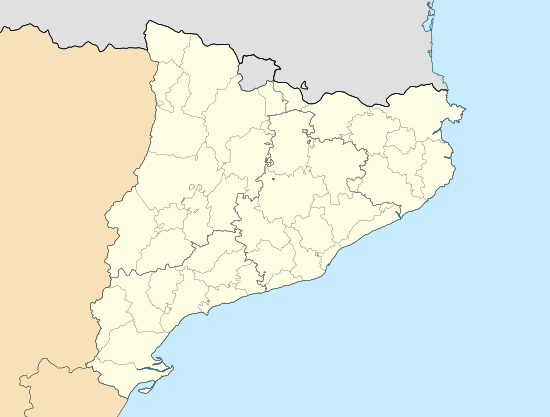Sant Boi de Llobregat
Sant Boi de Llobregat (IPA: [ˈsam ˈbɔj ðə ʎuβɾəˈɣat]) is a town in the Province of Barcelona in Catalonia, Spain, located on the banks of the Llobregat river. In 2019 it had 83,605 inhabitants.[4]
Sant Boi de Llobregat | |
|---|---|
Church of St. Baldiri | |
 Flag  Coat of arms | |
 Sant Boi de Llobregat Location within Catalonia  Sant Boi de Llobregat Location within Spain | |
| Coordinates: 41.336°N 2.043°E | |
| Country | |
| Community | |
| Province | Barcelona |
| Comarca | Baix Llobregat |
| Government | |
| • Mayor | Lluïsa Moret Sabidó (2015)[1] |
| Area | |
| • Total | 21.5 km2 (8.3 sq mi) |
| Population (2018)[3] | |
| • Total | 82,904 |
| • Density | 3,900/km2 (10,000/sq mi) |
| Demonym(s) | Santboià/-na |
| Website | stboi |
The town is divided into six districts: Ciutat Cooperativa-Molí Nou, Marianao-Can Paulet, Barri Centre, Vinyets-Molí Vell, Camps Blancs-Canons-Orioles, and Casablanca.[5]
It is bordered on the north by the towns of Santa Coloma de Cervelló and Sant Joan Despí and the village of Sant Climent de Llobregat; on the east by the town of Cornellà de Llobregat; on the west by Viladecans; and on the south by El Prat de Llobregat and the Mediterranean Sea (via a narrow southward salient).
Economy
Although the main business activity is trading, which is centered around the service sector, Sant Boi is also known for industrial activities, especially metallurgy. Agriculturally, its mild climate and fertile waterlogged lands, located at the mouth of the Llobregat river, produce a wide variety of vegetables, including the famous Llobregat delta artichokes. The region offers three different artichoke varieties: white artichoke from Tudela, camús from Bretagne (considered to be the largest variety) and artichoke from Benicarló. Production is concentrated mostly in March, but products can be found in local markets throughout the year.
Politics
The mayor of the town is Lluïsa Moret Sabidó (Socialists' Party of Catalonia, PSC), and the political composition of the city council seats is as follows:
- Socialists' Party of Catalonia: 10
- Initiative for Catalonia Greens: 4
- Citizens – Party of the Citizenry: 3
- Republican Left of Catalonia: 3
- Gent de Sant Boi: 2
- People's Party: 2
- Convergence and Union: 1
History
The finding of archaeological remains corresponding to Iberian colonies (VI-I bC) and to the Romans (I-V aC)―a noteworthy Roman bath is located near the river―suggests that Sant Boi was created in pre-Roman times.
As with most of the surrounding lands, from the 8th to the 11th century the town was controlled by the Moors, until their expulsion from Iberia during the Reconquista. The Moors called it Alcalá, which means "castle", due to the existence of a hillock from where the river and the valley were dominated. The town's current name is derived from the name of Saint Baudilus, known as Boi or Baldiri in Catalonia.[6]
During the Middle Ages, the village progressively grew, expanding from the castle's surroundings to adjacent zones. A baroque-style church was built during the 16th century. The growth continued in the following centuries, giving rise to numerous "masies" (typical Catalan agricultural country houses) near the river and fertile lands. By the end of the 19th century, Sant Boi was a village of nearly 5,000 inhabitants, with an economy driven mainly by agriculture.
In the early stages of the 20th century, industry arrived and subsequently flourished in Sant Boi, ranging from brick manufacturing to metalwork. With the end of the Spanish Civil War in 1939, there was a massive influx of immigrants from many different parts of Spain. These new arrivals consisted mostly of people from villages and small towns. They were searching for jobs and career opportunities in the city of Barcelona since it was stimulated by the regrowth of Catalan industry in post-war Spain.
The population rose from 10,000 people in 1940 to 65,000 in 1975. This period is characterized by the construction of complete quarters (Casablanca, Camps Blancs, and Cooperativa) for the housing of immigrants. Sant Boi is now a town with more than 80,000 inhabitants, with well-established industrial and service sectors, and good cultural and recreational offerings.
Demography
| 1900 | 1930 | 1950 | 1970 | 1986 | 2019 |
|---|---|---|---|---|---|
| 5,311 | 8,867 | 10,811 | 50,051 | 75,789 | 83,605 |
Notable places
- Sant Baldiri's Church
- Roman Bathhouses
- Sant Ramon Hermitage
Sport
The town has a rugby union club (UE Santboiana), and a football club (FC Santboià).
Prominent people from Sant Boi
- Sergio Aguza - footballer
- Carlos Casquero - former footballer
- Pau Gasol - NBA player (San Antonio Spurs)
- Marc Gasol - NBA player (Toronto Raptors)
- Both Gasol brothers were actually born in Barcelona, at the hospital where their parents worked. The family moved from another Barcelona suburb, Cornellà, to Sant Boi when Pau was 6 years old and Marc was a year old.
- Oriol Ripol - professional rugby player
- Manel Esteller - scientist
See also
References
- "Ajuntament de Sant Boi de Llobregat". Generalitat of Catalonia. Retrieved 2015-11-13.
- "El municipi en xifres: Sant Boi de Llobregat". Statistical Institute of Catalonia. Retrieved 2015-11-23.
- Municipal Register of Spain 2018. National Statistics Institute.
- "The municipality in figures". Statistical Institute of Catalonia. June 11, 2020.
- Pl. Ajuntament, Ajuntament de Sant Boi de Llobregat. "Who are we? - Sant Boi Cyti Hall". Ajuntament de Sant Boi de Llobregat. Retrieved June 30, 2020.
- Samboal
- Panareda Clopés, Josep Maria; Rios Calvet, Jaume; Rabella Vives, Josep Maria (1989). Guia de Catalunya, Barcelona: Caixa de Catalunya. ISBN 84-87135-01-3 (Spanish). ISBN 84-87135-02-1 (Catalan).
External links
- Artistic and historical buildings in Sant Boi de Llobregat (in Catalan)
- Sant Boi's City Council's Site
- Sant Boi's City Council's official statistic site in Catalan
- Government data pages (in Catalan)
.svg.png)